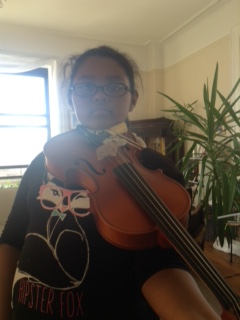by Rozanna Weinberger
Violin hold is one of the biggest enigmas for many string players from beginner to advancing players. Sure its easy enough to grip the violin between the head & neck like a vice until the pain becomes incapacitating. Its even possible to consider pain a necessary trade off for playing a beautiful musical instrument.
Imagine if a tight rope walker tried to cling to the rope between its toes to grip the rope. It really doesnt work and the tight rope walker would certainly fall to the ground. Problem is, a violinist won’t fall to their death but they will make playing much more difficult for themselves. Isn’t accuracy hard enough without making it harder for ourselves to play?
Observations: Without the instrument, raise the left shoulder to the head while compressing the neck towards the shoulder. Next bring up the arm as if to play the violin or viola. Notice how much the range of the arm is shortened when the space between the head, neck and shoulders is also shortened. This contraction makes it difficult to comfortably bring the arm around the instrument and this is especially unfortunate when trying to shift in high positions.

Bring the arm down. This time simply bring up the arm with a slightly bent elbow as if playing the violin. Of course theres no need to raise the shoulder or squeeze the head since theres no instrument to contend with. But imagine if it were possible to play while maintaining a similar feeling of length in the neck and shoulder!
Notice how easy it is to touch the fingers to your nose when a similar distance on the finger board can feel like a treacherous distance to navigate while holding the violin or viola. At the very least a decrease in squeezing the neck & shoulder makes it so much easier to get around the instrument.
While there are various theories on how to get around this issue, many of which involve a shoulder rest or other such device to position the violin to the body, such methods can short circuit the potential to balance the instrument. Why is this? Balance is an active experience with subtle changes and adjustments. Positioning an instrument is a far more static approach.

Catherine demonstrates when violin is tipped too far to the right.
Mind you plenty of string players have to deal with a long neck or sense that the distance between the head & shoulder needs to be filled up in some way. To a degree there are case by case physical considerations. Still the way we understand how to carry our upper bodies is a very big piece of the puzzle.
One factor this entry will address is angle of the violin as a clue on balancing the instrument. Notice how Catherine has the violin positioned too far too the right. This is one of the most common issues with beginners. Feels right because the player can stare down the fingerboard. And because gripping the instrument is the knee jerk approach it may seem easier to bare down with the chin when violin is positioned to much in front of the body.
Ultimately the player must discover where the real support needs to take place. Suffice it to say if the upper body is sufficiently supported by those illusive abdominal muscles most people engage when doing such activities as pilates, dance and other spine lengthening activities, the player will be less inclined to elevate the shoulders, which to a large degree can passively rest atop the rib cage rather than be used to hold the violin and body up. Using the shoulders in this manner is ultimately inefficient.

